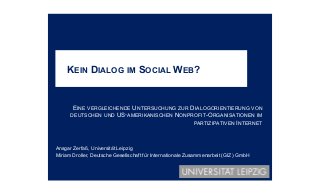
#onkomm13 - Panel 2 -Ansgar Zerfaß & Miriam Droller (Universität Leipzig): Kein Dialog im Social Web?
- 1. KEIN DIALOG IM SOCIAL WEB? EINE VERGLEICHENDE UNTERSUCHUNG ZUR DIALOGORIENTIERUNG VON DEUTSCHEN UND US‑AMERIKANISCHEN NONPROFIT-ORGANISATIONEN IM PARTIZIPATIVEN INTERNET Ansgar Zerfaß, Universität Leipzig Miriam Droller, Deutsche Gesellschaft für Internationale Zusammenarbeit (GIZ) GmbH
- 2. Dialog im Social Web: Eine Chance für Nonprofit-Organisationen? • Social Web Dialogpotenzial NPOs kein „kurzfristiger Hype“ • Wandel der öffentlichen Kommunikation und Meinungsbildung • Chance für das Kommunikationsmanagement: Dialoge im Social Web ermöglichen ein direktes Beziehungsmanagement • Social-Web-Anwendungen bergen lediglich ein Dialogpotenzial; die Dialogrealisierung hängt vom tatsächlichen Gebrauch ab • Stakeholder-Beziehungen bilden das „Kapital“ von Nonprofit-Organisationen (NPOs) Inwieweit nutzen NPOs das Social Web zur Dialogkommunikation mit ihren Stakeholdern und welche Faktoren fördern bzw. behindern diese dialogische Kommunikation? Ansgar Zerfaß & Miriam Droller | Kein Dialog im Social Web? | DGPuK-Tagung Onlinekommunikation 2013 2
- 3. Forschungsfragen 1 Inwieweit nutzen NPOs in ihrer externen Kommunikation das Dialogpotenzial des Social Web? 2 Wie unterscheidet sich die Dialogorientierung deutscher und US-amerikanischer NPOs im Social Web? 3 Welche unabhängigen Variablen beeinflussen die Dialogorientierung von NPOs im Social Web? Ansgar Zerfaß & Miriam Droller | Kein Dialog im Social Web? | DGPuK-Tagung Onlinekommunikation 2013 3
- 4. Theoretische Basis: Dialogkommunikation interaktive Kommunikation (dialogorientiert) Dialog • kein Rollenwechsel • (noch) kein Rollenwechsel • Rollenwechsel • Kommunikator steuert • Informationsabfrage • Offenheit & Dynamik • Zieldurchsetzung • Feedbackmöglichkeit • begrenzte Planbarkeit Monolog Quelle: eigene Darstellung in Anlehnung an Zerfaß 1996 Ansgar Zerfaß & Miriam Droller | Kein Dialog im Social Web? | DGPuK-Tagung Onlinekommunikation 2013 4
- 5. Theoretische Basis: Kent & Taylor (1998) Fünf Prinzipien für einen erfolgreichen dialogischen Beziehungsaufbau über Websites von Organisationen: 1 2 3 4 5 Dialogic Loop: Feedbackmöglichkeiten, schnelle Reaktion der Organisation Usefulness of Information: sinnvolle Strukturierung, automatische Verbreitung Generation of Return Visits: regelmäßige Aktualisierung, interaktive Kommunikation Intuitiveness/Ease of the Interface: benutzerfreundliche Gestaltung Rule of Conservation of Visitors: keine Ablenkung/Weiterleitung durch Werbung etc. Ansgar Zerfaß & Miriam Droller | Kein Dialog im Social Web? | DGPuK-Tagung Onlinekommunikation 2013 5
- 6. Empirisches Design • quantitative Online-Inhaltsanalyse • N = 100 deutsche und US-amerikanische NPOs • interaktive (dialogorientierte) & dialogische Kommunikation • organisationseigene Social Software (RSS-Feeds, Tagclouds, Wikis, Pod- und Vodcasts, Blogs und Social Plugins) & externe Social-Web-Anwendungen (YouTube, Facebook und Twitter) • Basis des Kategoriensystems: Kent & Taylor (1998), Abgrenzung des Dialogbegriffs sowie spezifische Eigenschaften der Social-Web-Anwendungen • Untersuchungszeitraum: 3 Monate Ansgar Zerfaß & Miriam Droller | Kein Dialog im Social Web? | DGPuK-Tagung Onlinekommunikation 2013 6
- 7. Operationalisierung: Social-Web-Dialog-Index (SWDI) Theoretische Basis Erstes Prinzip nach Kent/Taylor (1998) Sinnvolle Strukturierung Social-Web-Dialog-Index (SWDI) Automatische Verbreitung Website-Dialog-Index (WDI) Regelmäßige Aktualisierung Zweites Prinzip nach Kent/Taylor (1998) Feedbackmöglichkeit YouTube-Dialog-Index (YTDI) Nutzerbewertungen Drittes Prinzip nach Kent/Taylor (1998) Nutzerkommentare Organisationsantworten Dialogkommunikation Schnelle Reaktion der Organisation Facebook-DialogIndex (FDI) Twitter-Dialog-Index (TDI) Ansgar Zerfaß & Miriam Droller | Kein Dialog im Social Web? | DGPuK-Tagung Onlinekommunikation 2013 Indexwerte: 0 - 100 7
- 8. Operationalisierung: Social-Web-Dialog-Index (SWDI) Theoretische Basis Erstes Prinzip nach Kent/Taylor (1998) Sinnvolle Strukturierung Social-Web-Dialog-Index (SWDI) Automatische Verbreitung Website-Dialog-Index WDI: Ø 8 Punkte (WDI) Regelmäßige Aktualisierung Zweites Prinzip nach Kent/Taylor (1998) Feedbackmöglichkeit YouTube-Dialog-Index YTDI: Ø 18 Punkte (YTDI) Nutzerbewertungen Drittes Prinzip nach Kent/Taylor (1998) Nutzerkommentare Organisationsantworten Dialogkommunikation Schnelle Reaktion der Organisation Facebook-DialogFDI: Ø 25(FDI) Index Punkte Twitter-Dialog-Index TDI: Ø 16 Punkte (TDI) Ansgar Zerfaß & Miriam Droller | Kein Dialog im Social Web? | DGPuK-Tagung Onlinekommunikation 2013 Indexwerte: 0 - 100 8
- 9. 1. Kernergebnis: Dialoge finden – wenn überhaupt – auf externen Social-Web-Plattformen statt 23% Facebook-Kommentare Antwort-Tweets an Nutzer 31% Antwort-Tweets an Organisationen 30% YouTube-Videokommentare YouTube-Kanalkommentare Facebook-Diskussionen-App 49% 28% 5% 23% 2% 1% 5% 17% 16% Blogkommentare Podcastkommentare 1% c 0% Vodcastkommentare 0% c 0% Anteil der NPOs, die nur Dialog mit einem Rollenwechsel realisieren Anteil der NPOs, die Dialoge mit mehr als einem Rollenwechsel realisieren N = 100 NPOs (davon 56 mit Blog, 24 mit Podcast, 39 mit Vodcast, 87 mit Facebook-Präsenz, 76 mit Twitter-Kanal und 86 mit YouTubeKanal) Ansgar Zerfaß & Miriam Droller | Kein Dialog im Social Web? | DGPuK-Tagung Onlinekommunikation 2013 9
- 10. 2. Kernergebnis: US-amerikanische Organisationen sind KEIN Vorbild für Dialoge im Social Web 40% Facebook-Kommentare 8% Antwort-Tweets an Nutzer 54% 24% Antwort-Tweets an Organisationen 14% Blogkommentare YouTube-Videokommentare 2% Facebook-Diskussionen-App 58% 36% 18% 8% 0% 2% YouTube-Kanalkommentare 0% Podcastkommentare 0% 0% Vodcastkommentare 4% 0% 0% Signifikanz: 0,01-Niveau N = 100 NPOs (davon 50 deutsche und 50 US-amerikanische NPOs) Anteil der deutschen NPOs, die Dialoge mit mehr als einem Rollenwechsel realisieren Anteil der US-amerikanischen NPOs, die Dialoge mit mehr als einem Rollenwechsel realisieren Ansgar Zerfaß & Miriam Droller | Kein Dialog im Social Web? | DGPuK-Tagung Onlinekommunikation 2013 10
- 11. 3. Kernergebnis: Ein argumentativer Kommunikationsstil fördert Social-Web-Dialoge 1,51 Facebook-Posts 4,38 16,49 Blogbeiträge mit Kommentarmöglichkeit 0,29 0,49 4,14 Mittelwert der Nutzerkommentare bei einem informativen Kommunikationsstil Mittelwert der Nutzerkommentare bei einem persuasiven Kommunikationsstil Mittelwert der Nutzerkommentare bei einem argumentativen Kommunikationsstil Signifikanz: 0,01-Niveau Facebook-Posts: N = 1.151; Blogbeiträge mit Kommentarmöglichkeit: N = 538 Ansgar Zerfaß & Miriam Droller | Kein Dialog im Social Web? | DGPuK-Tagung Onlinekommunikation 2013 11
